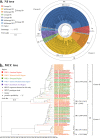Molecular Evolution of Human Parainfluenza Virus Type 2 Based on Hemagglutinin-Neuraminidase Gene
- PMID: 37039701
- PMCID: PMC10269610
- DOI: 10.1128/spectrum.04537-22
Molecular Evolution of Human Parainfluenza Virus Type 2 Based on Hemagglutinin-Neuraminidase Gene
Abstract
To understand the molecular evolution of human parainfluenza virus type 2 (HPIV2), 21 Hemagglutinin-Neuraminidase (HN) gene sequences covering seven Chinese provinces in 2011 and 2017 to 2021 were combined with 90 published HN sequences worldwide for phylogenetic analysis. The result showed that global HPIV2 could be classified into two distinct clusters (I and II), five lineages (IA to IIE), and four sublineages (IB1 and 2, and IIE1 and 2). The minimum genetic distances between different clusters and lineages were 0.049 and 0.014, respectively. In the last decade, one lineage (IID) and three sublineages (IB1, IB2, and IIE1) have been cocirculating in China, with the sublineages IB2 and IIE1 dominating, while sublineages IB1 and IIE1 are dominant globally. In addition, the spread of HPIV2 had relative spatial clustering, and sublineage IB2 has only been detected in China thus far. The overall evolution rate of HPIV2 was relatively low, on the order of 10-4 substitutions/site/year, except for sublineage IB2 at 10-3 substitutions/site/year. Furthermore, human-animal transmission was observed, suggesting that the HPIV2 might have jumped out of animal reservoirs in approximately 1922, the predicted time of a common ancestor. The entire HN protein was under purifying/negative selection, and the specific amino acid changes and two novel N-glycosylation sites (N316 and N517) in sublineages IB1, IB2, and IIE1 were mostly located in the globular head region of the HN protein. In this study, preliminary evolutionary characteristics of HPIV2 based on the HN gene were obtained, increasing the recognition of the evolution and adaptation of HPIV2. IMPORTANCE The phylogenetic analysis showed that global HPIV2 could be classified into two distinct clusters (I and II) and five lineages (IA to IIE) with at least 0.049 and 0.014 genetic distances between clusters and lineages, respectively. Furthermore, lineages IB and IIE could be further divided into two sublineages (IB1-2 and IIE1-2). All China sequences belong to one lineage and three sublineages (IB1, IB2, IID, and IIE1), among which sublineages IB2 and IIE1 are predominant and cocirculating in China, while sublineages IB1 and IIE1 are dominant globally. The overall evolution rate of HPIV2 is on the order of 10-4 substitutions/site/year, with the highest rate of 2.18 × 10-3 for sublineage IB2. The entire HN protein is under purifying/negative selection, and the specific amino acid substitutions and two novel N-glycosylation sites (N316 and N517) in sublineages IB1, IB2, and IIE1 are mostly located in the globular head region of the HN protein.
Keywords: Bayesian analysis; genotyping; human parainfluenza virus type 2; molecular evolution.
Conflict of interest statement
The authors declare no conflict of interest.
Figures



Similar articles
-
Genetic characteristics of human parainfluenza viruses 1-4 associated with acute lower respiratory tract infection in Chinese children, during 2015-2021.Microbiol Spectr. 2024 Oct 3;12(10):e0343223. doi: 10.1128/spectrum.03432-23. Epub 2024 Sep 12. Microbiol Spectr. 2024. PMID: 39264196 Free PMC article.
-
The Fusion Protein Specificity of the Parainfluenza Virus Hemagglutinin-Neuraminidase Protein Is Not Solely Defined by the Primary Structure of Its Stalk Domain.J Virol. 2015 Dec;89(24):12374-87. doi: 10.1128/JVI.01448-15. Epub 2015 Sep 30. J Virol. 2015. PMID: 26423949 Free PMC article.
-
Sequence determination of the hemagglutinin-neuraminidase (HN) gene of human parainfluenza type 2 virus and the construction of a phylogenetic tree for HN proteins of all the paramyxoviruses that are infectious to humans.Virology. 1990 Jan;174(1):308-13. doi: 10.1016/0042-6822(90)90081-2. Virology. 1990. PMID: 2152995
-
Genetic diversity among human parainfluenza virus type 2 isolated in Croatia between 2011 and 2014.J Med Virol. 2016 Oct;88(10):1733-41. doi: 10.1002/jmv.24532. Epub 2016 Apr 4. J Med Virol. 2016. PMID: 27004845
-
New antiviral approaches for human parainfluenza: Inhibiting the haemagglutinin-neuraminidase.Antiviral Res. 2019 Jul;167:89-97. doi: 10.1016/j.antiviral.2019.04.001. Epub 2019 Apr 3. Antiviral Res. 2019. PMID: 30951732 Review.
Cited by
-
Molecular Evolution of the Fusion (F) Genes in Human Parainfluenza Virus Type 2.Microorganisms. 2025 Feb 12;13(2):399. doi: 10.3390/microorganisms13020399. Microorganisms. 2025. PMID: 40005765 Free PMC article.
-
Genetic characteristics of human parainfluenza viruses 1-4 associated with acute lower respiratory tract infection in Chinese children, during 2015-2021.Microbiol Spectr. 2024 Oct 3;12(10):e0343223. doi: 10.1128/spectrum.03432-23. Epub 2024 Sep 12. Microbiol Spectr. 2024. PMID: 39264196 Free PMC article.
-
Phylogenomic Analyses of the Hemagglutinin-Neuraminidase (HN) Gene in Human Parainfluenza Virus Type 4 Isolates in Japan.Microorganisms. 2025 Feb 10;13(2):384. doi: 10.3390/microorganisms13020384. Microorganisms. 2025. PMID: 40005750 Free PMC article.
-
Molecular Evolutionary Analyses of the Fusion Genes in Human Parainfluenza Virus Type 4.Microorganisms. 2024 Aug 9;12(8):1633. doi: 10.3390/microorganisms12081633. Microorganisms. 2024. PMID: 39203475 Free PMC article.
References
-
- Wang X, Li Y, Deloria-Knoll M, Madhi SA, Cohen C, Arguelles VL, Basnet S, Bassat Q, Brooks WA, Echavarria M, Fasce RA, Gentile A, Goswami D, Homaira N, Howie SRC, Kotloff KL, Khuri-Bulos N, Krishnan A, Lucero MG, Lupisan S, Mathisen M, McLean KA, Mira-Iglesias A, Moraleda C, Okamoto M, Oshitani H, O'Brien KL, Owor BE, Rasmussen ZA, Rath BA, Salimi V, Sawatwong P, Scott JAG, Simões EAF, Sotomayor V, Thea DM, Treurnicht FK, Yoshida LM, Zar HJ, Campbell H, Nair H. 2021. Global burden of acute lower respiratory infection associated with human parainfluenza virus in children younger than 5 years for 2018: a systematic review and meta-analysis. Lancet Glob Health 9:e1077–e1087. doi: 10.1016/S2214-109X(21)00218-7. - DOI - PMC - PubMed
Publication types
MeSH terms
Substances
LinkOut - more resources
Full Text Sources
Medical

